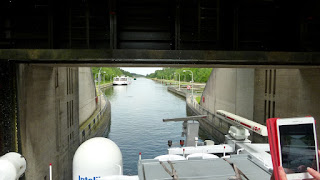I thought I would entertain you with some workings of locks on the river and how the ship copes with very low bridges.
We are now on the Rhine - Main - Danube canal, joining the two major rivers of Europe and allowing shipping traffic to travel from the Black Sea in the east to the North Sea. It is three times shorter than the same trip via the Mediterranean and the ocean. However, because of geography and changing levels along the river, locks are needed to raise and lower the shipping.
 |
| Leerstetten lock |
Here is one of the deepest locks at Leerstetten, 24.6 meters or 90 feet. It is one of three locks that are 90 feet in displacement.
 |
| Waiting to enter lock |
Here is our ship is parked at the side waiting to enter the lock. Another ship at the bottom of the lock is currently coming up.
 |
| Ship in lock |
Here's the other ship just coming into view as it rises from the bottom of the lock. Notice the gate in front of it.
 |
| Lock gate descending |
Here you can see the upstream gate descending to allow the other ship to leave the lock. It cannot descend until the water levels on both sides of the gate are equal.
 |
| Ship leaving lock |
Now the gate is fully down, the ship can leave the lock and we can now enter it.
 |
| Entering the lock |
Here we are slowly entering the lock. The lock is 12 meters wide, our ship is 11.4 meters wide, leaving just 30 cm clearance on either side. So skilled is the pilot that he guides the ship in, all 135 meters of it, without touching the sides.
 |
| In the lock |
Here we are, fully in the lock and tethered to the side. Behind us the upstream gate is raising into position in preparation for draining the lock to descend us to the lower level.
 |
| Going down |
The water is being released from the lock and we have begun descending. Note the water line to see how far we have actually gone at this point.
 |
| Still going down |
 |
| Bottom gate emerging |
Finally the downstream gate emerges from the water, 20 meters down.
 |
| Downstream gate raising |
Now the water level is equal with the water on the other side, the downstream gate begins to open.
 |
| Holding pens for water |
Now, you're probably wondering where all that water goes when the lock empties - well wonder no more. Behold, the holding pens for the water next to the lock. About 80% of the water is recycled, some escapes downstream but the locks are kept topped up by an artificial lake constructed next to the canal.
 |
| Downstream gate fully open |
Note the entire wall does not open, it's just too big. The downstream gate is large enough to let the ships go through and no larger!
 |
| Exiting the lock |
25 meters (90 feet down) we slowly glide out of the lock.
 |
| Not much head room |
As you can see, there isn't much clearance at the bottom!
 |
| Aqueduct |
This canal also has a unique feature in that it has an aqueduct that crosses a road below it. The canal is 171 km long and was first conceived in 793 A.D. by Charlemagne the Great. Unfortunately, the technology of the time was not up to the challenge so the project was shelved. It wasn't till 1834 that Ludwig I of Bavaria passed a law for the construction of the canal. It was called, strangely enough, the Ludwig canal and was completed in 1844 after 8 years of construction.
 |
| Aerial view of aqueduct |
As soon as it was built it was too narrow for shipping so it had limited use until 1962 when the current canal's construction was commenced, completing in 1992. The canal cost 2.3 billion euros to build, and has 16 locks ranging from 6 meters high to 24.6 meters.
 |
| Very low bridge |
Something else the canal has plenty of and that is very low bridges. We're not allowed on top of the ship when these come near so this is the closest I could come to this bridge.
 |
| Wheelhouse |
This is the wheelhouse. It has a unique feature.
The bridges are so low, the clearance is insufficient for the wheelhouse to go under it so...the wheelhouse goes down - it sits on hydraulic rams that can lower it.
So here it is going down lower...
And finally it is so low, the pilot has to open a hatch in the roof and poke his head through to see where he's going. What happens when he reaches the bridge? He ducks!
BTW, you can click on the pictures to see them larger.






















No comments:
Post a Comment